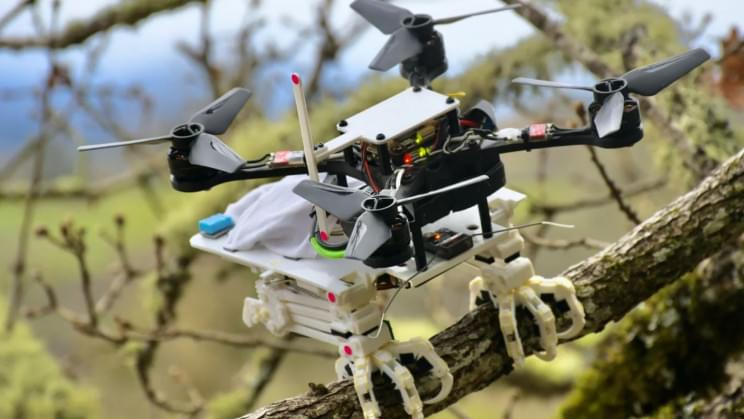SpaceX launches, Tesla updates its terms and conditions, and Elon Musk sighs.
SpaceX launches NASA’s DART spacecraft with its Falcon 9 rocket, Tesla updates its terms and conditions for Full Self-Driving, and Elon Musk sighs about it.
SpaceX launches, Tesla updates its terms and conditions, and Elon Musk sighs.
SpaceX launches NASA’s DART spacecraft with its Falcon 9 rocket, Tesla updates its terms and conditions for Full Self-Driving, and Elon Musk sighs about it.
One of the first goals of quantum computing has been to recreate bizarre quantum systems that can’t be studied in an ordinary computer. A dark-horse quantum simulator has now done just that.
Circa 2017
“Enabling early detection of diseases is one of the greatest opportunities we have for developing effective treatments,” Esfandyarpour said. “Maybe $1 in the U.S. doesn’t count that much, but somewhere in the developing world, it’s a lot of money.”
A two-part system
A combination of microfluidics, electronics and inkjet printing technology, the lab-on-a-chip is a two-part system: A clear silicone microfluidic chamber for housing cells sits on top of a reusable electronic strip.

Circa 2018 #artificialintelligence #doctor
Abstract: Online symptom checkers have significant potential to improve patient care, however their reliability and accuracy remain variable. We hypothesised that an artificial intelligence (AI) powered triage and diagnostic system would compare favourably with human doctors with respect to triage and diagnostic accuracy. We performed a prospective validation study of the accuracy and safety of an AI powered triage and diagnostic system. Identical cases were evaluated by both an AI system and human doctors. Differential diagnoses and triage outcomes were evaluated by an independent judge, who was blinded from knowing the source (AI system or human doctor) of the outcomes. Independently of these cases, vignettes from publicly available resources were also assessed to provide a benchmark to previous studies and the diagnostic component of the MRCGP exam. Overall we found that the Babylon AI powered Triage and Diagnostic System was able to identify the condition modelled by a clinical vignette with accuracy comparable to human doctors (in terms of precision and recall). In addition, we found that the triage advice recommended by the AI System was, on average, safer than that of human doctors, when compared to the ranges of acceptable triage provided by independent expert judges, with only a minimal reduction in appropriateness.
From: Yura Perov N [view email]
[v1] Wed, 27 Jun 2018 21:18:37 UTC (54 KB)
Biodiversity conservation, public health and improved livelihoods — dr gladys kalema-zikusoka, founder and CEO, conservation through public health.
Dr. Gladys Kalema-Zikusoka, is the Founder and CEO of Conservation Through Public Health (CTPH — https://ctph.org/), a 16-year old non-profit organization, based in Uganda, that promotes conservation by improving the quality of life of people and wildlife to enable them to coexist in and around protected areas in Africa, and she has become one of the leading conservationists and scientists working to save the critically endangered mountain gorillas of East Africa.
Dr. Kalema-Zikusoka is also on the Scientific Advisory Group for the Origins of Novel Pathogens (SAGO) of the World Health Organization (https://www.who.int/groups/scientific-advisory-group-on-the-…ago)/about)
Dr. Kalema-Zikusoka trained as a veterinarian at the University of London’s Royal Veterinary College. Between 1996 and 2000, she set up the first Veterinary Unit at the Uganda Wildlife Authority. From 2000 to 2003, she completed a zoological medicine residency and masters in specialized veterinary medicine at North Carolina State University and North Carolina Zoological Park.
Dr. Kalema-Zikusoka became an Ashoka Fellow in 2007 for merging Uganda’s wildlife management and rural public health programs to create common resources for both people and animals.
Bridging Technology And Medicine For The Modern Healthcare Ecosystem — Dr. Mona G. Flores, MD, Global Head of Medical AI, NVIDIA.
Dr. Mona Flores M.D., is the Global Head of Medical AI, at NVIDIA (https://blogs.nvidia.com/blog/author/monaflores/), the American multinational technology company, where she oversees the company’s AI initiatives in medicine and healthcare to bridge the chasm between technology and medicine.
Dr. Flores first joined NVIDIA in 2018 with a focus on developing their healthcare ecosystem. Before joining NVIDIA, she served as the chief medical officer of digital health company Human-Resolution Technologies after a 25+ year career in medicine and cardiothoracic surgery.
Dr. Flores received her medical degree from Oregon Health and Science University, followed by a general surgery residency at the University of California at San Diego, a Postdoctoral Fellowship at Stanford, and a cardiothoracic surgery residency and fellowship at Columbia University in New York.
Dr. Flores also has a Masters of Biology from San Jose State and an MBA from the University at Albany School of Business. She initially worked in investment banking for a few years before pursuing her passion for medicine and technology.

Good news, everyone! We’ve been selected for a Gitcoin grant partnership to help democratize and incentivize future funding for our upcoming feature-length film’s development.
Gitcoin grants operate with crypto under a system known as “Quadratic Funding.” In other words, amounts are important, but the number of people donating also helps tremendously by boosting matching funds from a pre-established pool. So even small donation amounts can be hugely helpful. Therefore, any donation we receive from you will then be matched at an ever-increasing amount with each new donation.
We’re very excited to see where this takes us and if you’d like to contribute to the financing with more bang for your buck, check out the link below and start donating!
“The Last Generation to Die” is a cinematic quality full feature film on longevity. It’s a drama set in the future that examines the estranged relationship of two generations on the cusp of the end of aging and the ultimate merging of science and nature that will usher humanity into the next stage of evolution.
Logline: In a near future when age reversal therapies are on the cusp of becoming reality, a scientist tries to save her father from natural death.
“The Last Generation to Die” began its life as a staff-picked, 393% funded Kickstarter short film. We’re extending that life as a full feature length film. The short film was in a variety of festivals, garnering excellent reviews, and serves as a proof-of-concept for the full length feature film.
1988, the first self-replicating computer worm is unleashed on Earth.
–
The Homeless Hacker documentary is available: https://www.disrupt.plus/show/9e4baf05-3ffd-4a31-c3d4-08d9b18f9584
Disrup[tv]: https://www.youtube.com/playlist?list=PLKIaC1iW4R8oEU-5wpPvFZXx3_5ieRVGC
Soundtrack: https://www.youtube.com/playlist?list=PLKIaC1iW4R8pLdK0CLnrC40g5C6mODV3F
Discord: https://discord.gg/SnPUBBq.
Bumper by: https://www.youtube.com/c/suushedits.
Bumper song: https://www.youtube.com/watch?v=mgtm59rOxB0
Source: https://spaf.cerias.purdue.edu/tech-reps/823.pdf.
Thumbnail: https://www.artbreeder.com/i?k=bd217632b9070eec2a311f515fb5
Chapters:
0:00 Intro.
1:26 Morris. Worm Function.
4:05 The Spread of Morris. Worm.
5:48 NO SIGNAL Bump.
5:58 Homeless Hacker Ad.
7:05 The Unravelling of Morris. Worm.
11:27 DisruptVoice.com Caller

To say we’re at an inflection point of the technological era may be an obvious declaration to some. The opportunities at hand and how various technologies and markets will advance are nuanced, however, though a common theme is emerging. The pace of innovation is moving at a rate previously seen by humankind at only rare points in history. The invention of the printing press and the ascension of the internet come to mind as similar inflection points, but current innovation trends are being driven aggressively by machine learning and artificial intelligence (AI). In fact, AI is empowering rapid technology advances in virtually all areas, from the edge and personal devices, to the data center and even chip design itself.
There is also a self-perpetuating effect at play, because the demand for intelligent machines and automation everywhere is also ramping up, whether you consider driver assist technologies in the automotive industry, recommenders and speech recognition input in phones, or smart home technologies and the IoT. What’s spurring our recent voracious demand for tech is the mere fact that leading-edge OEMs, from big names like Tesla and Apple, to scrappy start-ups, are now beginning to realize great gains in silicon and system-level development beyond the confines of Moore’s Law alone.

Don’t worry, you’re safe.
Engineers from Stanford University created a robot that can grasp irregular objects.
The robot, called Stereotyped Nature-inspired Aerial Grasper (SNAG), is inspired by peregrine falcons, which is the fastest animal on earth reaching 200 miles per hour (320 km) when diving. … See more.